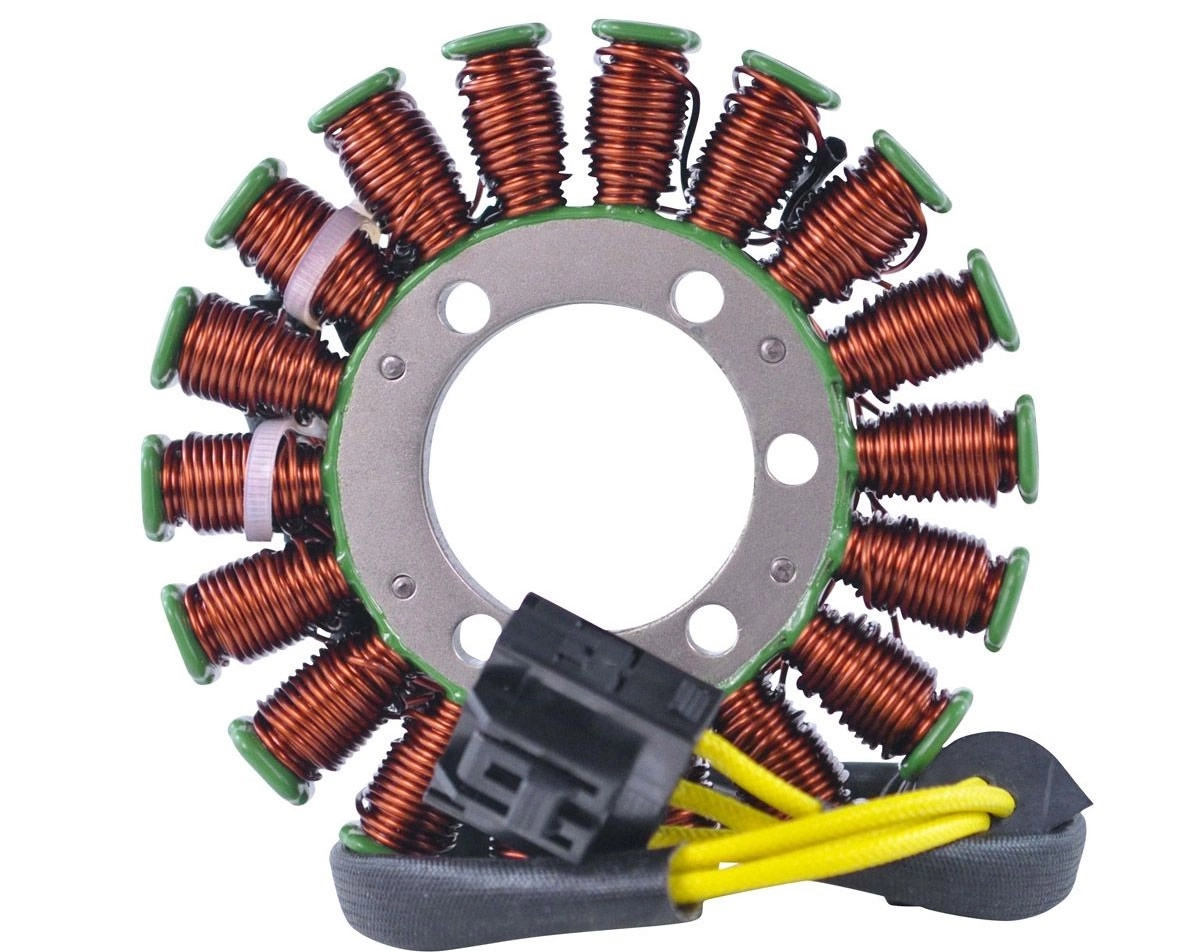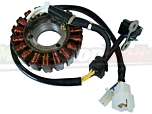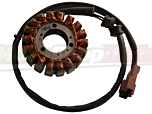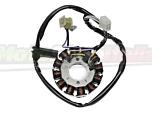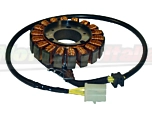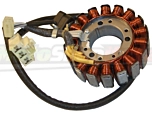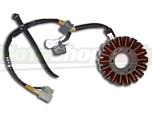Stators play a crucial role in the engines of motorcycles or scooters. They are not just components, but super important mechanisms in the electrical system. The importance of the stator is revealed in several aspects.
Let's see them together.
First of all, it is the generator of alternating current. Without it, the motorcycle would not have the necessary energy to function properly. Think of when we turn on the headlights or use the horn. These actions are possible thanks to the current generated by the stator.
Secondly, the stator helps to keep the motorcycle battery charged. During riding, the battery discharges. However, the stator continues to recharge it, ensuring that the motorcycle is always ready for use. It's like having a small built-in charger.
Then, there's the cooling theme. The stator, especially in high-performance motorcycles, contributes to reducing overheating. It works similarly to a fan, helping to disperse heat. Imagine it as a little wizard fighting against excessive heat.
But it doesn't end there. The stator also affects the longevity of the engine. With proper energy generation and an effective cooling system, it reduces engine wear.
Finally, its influence extends to the ride itself. A motorcycle or scooter with a functioning stator are smoother, more responsive. It's the difference between a pleasant ride and one full of hitches.
So, the stator is not just a piece of metal. It is a vital component that makes the magic of motorcycling possible. Without it, our riding experience would be quite different, devoid of that spark that makes every motorcycle journey unique.
Definition and Function of the Stator in the Motorcycle
The stator is a fundamental component in every motorcycle, essential for its operation. But what exactly does it do?
In simple terms, it is the heart of the motorcycle's energy generation system. It works in tandem with the rotor to produce electrical current. The rotor, driven by the engine, spins around the stator. This movement creates the electrical energy needed to power the motorcycle.
The stator has a coil structure, wound around an iron core. These coils are crossed by a magnetic flux generated by the rotor, thus producing electrical current. It's a bit like a small hydroelectric plant, where the water (in this case the magnetic flux) moves a turbine (the coils) to generate energy.
A practical example? When you start the motorcycle, the electrical system activates. From the headlights to the ignition, everything depends on the energy produced by the stator. It's like a miniature power plant, working silently under the seat.
But it's not limited to producing energy. As we also said earlier, the stator also has a role in keeping the battery charged. While you drive, the battery is consumed, but thanks to the stator, it is continuously recharged. It's a self-sufficient system that ensures your motorcycle a constant supply of energy.
Another important aspect is the regulation of voltage. The stator produces alternating current, which is then converted into direct current through the voltage regulator. This process ensures that the current supplied to the various electrical components is stable and safe. Without it, harmful overvoltages could occur.
Factors that Influence the Lifespan of the Stator
The lifespan of a stator in a motorcycle is influenced by several key factors.
Understanding these elements can help keep the motorcycle in good condition for a longer period.
The first fundamental aspect is the quality of the material. Stators are made with different materials, and their quality can vary considerably. A stator built with high-quality materials will be more resistant and durable. Imagine building a house: using superior quality bricks will ensure a more solid and lasting structure.
The conditions of use play a crucial role. If you use the motorcycle in extreme conditions, such as off-road paths or very dusty environments, the stator may wear out more quickly. It's like running on a rough road: the harder the path, the greater the wear on the shoes.
Then there's maintenance. This is perhaps the most controllable aspect. Regular maintenance of the stator can significantly extend its life. Periodic checks, cleaning of parts, and timely replacement of worn components are essential. It's similar to caring for a plant: with the right water and pruning, it will bloom for a long time.
Practical examples? Consider two motorcyclists: one mainly rides in the city and the other on dirt roads. The latter will probably have to replace the stator before the first one, due to more demanding conditions.
Another example is the difference between a motorcycle that receives regular maintenance and one that is neglected. The regularly maintained motorcycle will have a stator that works more efficiently and for a longer period.
Common Signs of Stator Wear
Recognizing the signs of stator wear is crucial to keeping your motorcycle in good condition.
There are some clear indicators that suggest when the stator is beginning to fail.
One of the first signs is a decrease in electrical performance. If you notice that the headlights of your motorcycle are dimming or that the horn seems less powerful, it could be a sign that the stator is not generating enough energy. It's like when the batteries of a flashlight start to run out and the light becomes weaker.
Another symptom is difficulty in starting the engine. If the motorcycle struggles to start, especially in the morning or in cold conditions, it might be a sign that the stator is not correctly recharging the battery. It's like trying to start a car with an almost dead battery.
Then, there's the anomaly in the engine sound. If the engine emits unusual noises or seems to run irregularly, it could be due to a problem with the stator. It's like when an appliance starts making strange noises: often it's a sign that something is wrong.
A clear sign is excessive heating. If the stator overheats, it could be an indicator of an internal malfunction. It's like touching a radiator that's too hot: it's a clear sign that something is working too hard.
Finally, a visual check can reveal signs of corrosion or physical damage to the stator. These are unmistakable signs that the stator needs attention.
Recognizing these signs is crucial to preventing greater damage to the motorcycle. Ignoring them could lead to more serious and costly breakdowns.
Average Lifespan of a Stator: Data and Statistics
The average lifespan of a motorcycle stator, based on user discussions and specific experiences, generally varies from 40,000 to 60,000 kilometers.
This range can depend on several factors, such as the specific model of the motorcycle and the conditions of use.
For example, for the Honda VFR 800 VTEC, the average lifespan of the stator has been indicated around 50,000 kilometers.
Improving the Lifespan of the Stator: Practical Tips
To improve the lifespan of the stator, here are some practical tips:
- Regular maintenance: perform periodic checks. Like a medical check-up, early diagnosis can prevent major problems.
- Cleaning: keep the stator clean. Dust and dirt can cause premature wear, just like leaving dirt on clothes.
- Temperature control: make sure the cooling system is working well. An overheated engine can damage the stator, similar to overcooking food. Avoid overloads: do not overload the electrical system. It's like avoiding overloading an electrical outlet at home.
- Timely replacement of related components: change parts like the voltage regulator if necessary. It's like changing car tires when they are worn out.
- Appropriate use: avoid driving in extreme conditions unnecessarily. It's like wearing suitable shoes for each activity.
Following these steps can help extend the life of the stator, ensuring a better driving experience and lower maintenance costs.
Choosing the Right Stator: Factors to Consider
Choosing the right stator for your motorcycle requires attention to several key factors:
- Compatibility with the motorcycle model: it is essential that the stator be specifically designed for the model and year of your motorcycle. A mismatch can lead to performance and safety issues.
- Quality of material and construction: high-quality materials ensure greater durability and reliability. Look for stators built with materials resistant to heat and wear.
- Manufacturer's reputation: choose a manufacturer known for the quality and reliability of its products. Reputation can be a good indicator of the stator's lifespan.
- Customer reviews and feedback: look for online reviews and opinions of other motorcyclists. Others' experiences can provide valuable information on the performance and lifespan of the stator.
- Warranty and after-sales support: a good warranty can offer peace of mind. Also, check the availability of technical support in case of problems or questions.
- Price in relation to quality: evaluate the quality-price ratio. A cheaper product may cost more in the long term if it requires frequent replacements or repairs.
Considering these factors, you can make an informed choice that will ensure the best possible functioning for your motorcycle. In our store, you can find absolutely quality stators at a very competitive price.
Installation and Maintenance of the Stator: Key Steps
After purchasing the stator from MotoshopItalia, here's how to proceed for effective installation and maintenance:
- First of all, get prepared: before starting, make sure you have read the specific instructions for your motorcycle model. It's important to have all the necessary tools for installation.
- Remove the old stator: make sure the motorcycle is off and the battery disconnected to avoid any risk. Carefully remove the old stator, taking care not to force or break anything. It's a delicate job, like when you disassemble a piece of an electronic device.
- Install the new stator: once the old stator is removed, position the new one. Be very careful not to damage the coils and to correctly connect the cables, following the instructions.
- Check the connections: after installing the stator, it is crucial to check that all connections are secure and well made. This step is fundamental for safety and correct operation of the motorcycle.
- Initial test: once everything is connected and seems in order, restart the motorcycle and do a short test to make sure the stator is working as it should.
- Regular maintenance: finally, don't forget that even after installation, the stator requires regular maintenance. Periodic checks of the stator and the electrical system are essential to keep the motorcycle in good condition and prevent future problems. These steps will help you ensure that the stator is installed correctly and that your motorcycle functions at its best.
Conclusions: Maximizing the Lifespan of the Stator for Better Motorcycle Efficiency
Maximizing the lifespan of the stator is crucial to keep your motorcycle efficient and reliable. Remember, a well-maintained stator means fewer breakdowns and optimal performance. Follow regular maintenance advice, use quality materials, and listen to your motorcycle: small signals can indicate when it's time for a check.
Finally, if you're looking for a new stator or need advice, consider MotoshopItalia as your destination. You will find a wide range of high-quality products and an expert team ready to help you.

 Italiano
Italiano
